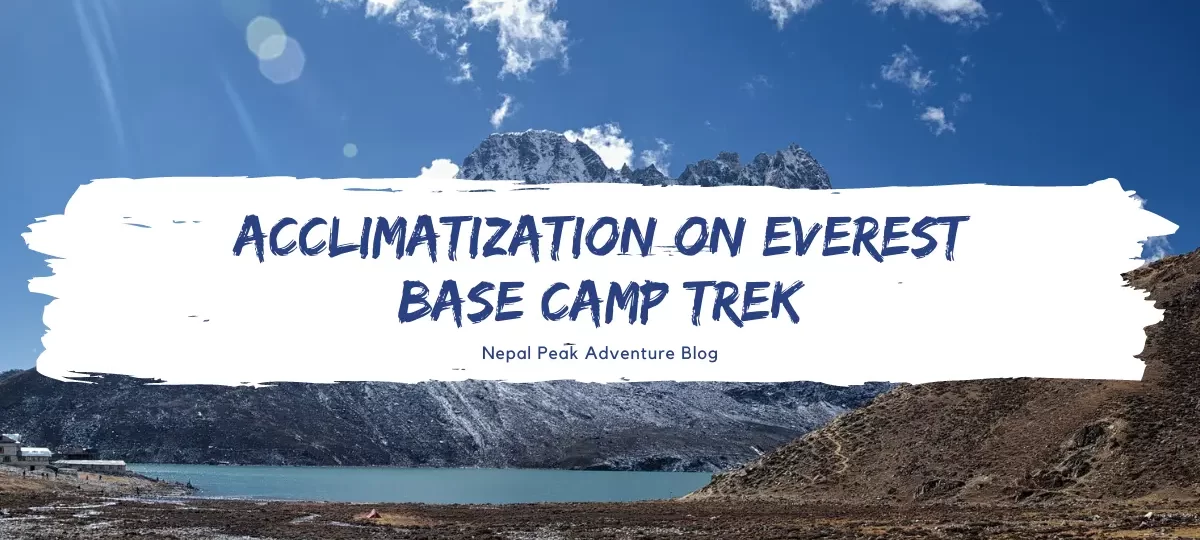Acclimatization on Everest Base Camp Trek: Why It’s Important and How to Do It
When trekking in Nepal that is above 2,500m, you may have heard word acclimatization day or also seen in the package itinerary, right? If you don’t know about it then, we will cover the main topic “Acclimatization on Everest Base Camp Trek & Why it’s important & How to do it”.
Table of Contents
What is acclimatization when trekking?
Acclimatization when trekking means a process of adapting your body to high altitude above 3,000m like Everest Base Camp which also has lower oxygen level.
During acclimatization, your body will have enough rest to produce more red blood cells which is very important to transport more oxygen to muscle & organs. This process allows body to adjust to lower oxygen which prevents from altitude sickness.
Importance of Acclimatization on the Everest Base Camp Trek
The whole Everest Base Camp trek falls above 2,500m (Lukla-2,800m & EBC-5,364m) which is considered to be the border line for the cause of altitude sickness. This is where the importance of acclimatization comes in.
With proper acclimatization, you will not get altitude illness and you will complete trek on time. Here are some other reasons why acclimatization is important:
- Prevents Altitude Sickness:
The no 1 importance of acclimatization on the Everest Base Camp Trek is to prevent from altitude illness like AMS, HAPE, & HACE. Altitude illness can get life-threatening if left untreated. These are also the factors for Everest Base Camp Trek difficulty. - Promotes Overall Health & Well-Being:
Acclimatization helps in maintaining good health & energy needed for trekking by reducing fatigue, dizziness, & shortness of breath. - Higher Chance to complete the trek properly:
Acclimatization also helps in increasing the chance of completing the trek properly & safely. The more your body gets good rest, the more energy you will have for the trek. - More Chance to Enjoy the Nature:
During Acclimatization period, you will have enough time to roam around the villages or hike to small hills. You can enjoy the scenery and Mountain View without worrying about altitude illness.
Therefore, acclimatization on the Everest Base Camp is a crucial aspect. Usually, you will have acclimatization in Namche Bazar (3,440m) & Dingboche (4,410m) which is the best place to have acclimatization. There are other best things you can do while Everest Base Camp Trek too.
How to Effectively follow Acclimatization on Everest Base Camp Trek

A day with resting or sleeping during acclimatization is a mistake that al lot of trekkers do. During acclimatization, the most effective way to acclimatize is by roaming around villages or hiking to hills.
Here are some other effective way to acclimatize on the Everest Base Camp:
- Staying Hydrated:
Staying hydrated during acclimatization is the best way to help your body adapt the altitude. There are many ways to keep your body hydrated like drinking herbal tea, water, soup & fluids. - Hike to higher hills:
When acclimatization in Namche Bazar, you can hike to Everest View Point where you can have a stunning view of Mount Everest. Similarly, at Dingboche, hike to Nagkartsang Peak during acclimatization.
Hiking during this acclimatization is not very hard and helps in adjusting the body to higher altitude. - Practice Deep Breathing Exercises:
Deep breathing exercises help increase oxygen intake and proper oxygen transfer in body & organs through blood. Similarly, it also helps in increasing the red blood cells. - Eating a Balanced Diet that counter Altitude Sickness:
First of all, having a proper balanced meal that have all necessary nutrition is necessary. Similarly, foods like garlic soup & foods that is rich in carbohydrate can counter altitude illness.
Overall, you should also know how to effectively acclimatize instead of just resting during rest days. Trekking guides will also give you instructions or activities that will help you acclimatize properly. By following these tips, you will surely have a safe & enjoyable trekking experience.
Common Symptoms of Altitude Sickness that you should be Aware of:
It is important to be aware of the symptoms of altitude sickness so that it can be treated as soon as possible. The sooner it gets treated the sooner you can continue your trek.
So, here are the common symptoms of altitude sickness that you should be aware of:
- Nausea & Vomiting
Loss of appetite accompanied with nausea & vomiting are the common symptoms of altitude sickness. - Fatigue
- Shortness of Breath:
Even after resting during the trek, if you feel shortness of breath time to time then it is a symptoms of altitude sickness. - Insomnia
- Continuous Headache
- Confusion & Disorientation.
- Swelling of hands, feet, or face.
Conclusion:
In conclusion, acclimatization on Everest Base Camp Trek is an important factor. By following the tips outlined in this guide, such as staying hydrated, hiking, practicing deep breathtaking exercise & eating balanced diet, you can counter altitude illness.
It is also important to look out for common symptoms & seek medical attention when needed. A proper acclimatization is what makes the trek safe & enjoyable.




1 Comment
Thanks for excellent information I was looking for this information for my mission.